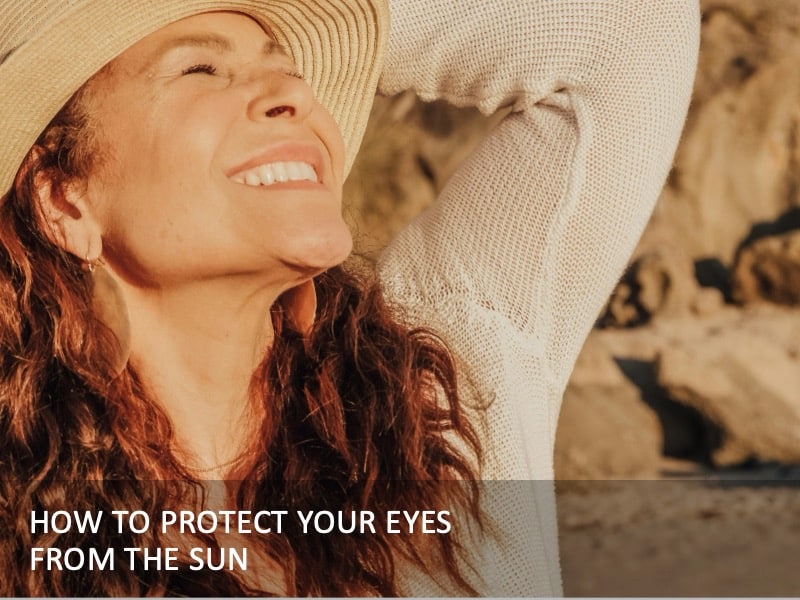How to Protect Your Eyes From the Sun
Spending time in the sun can have health benefits, including boosting your body’s ability to generate vitamin D and lowering blood pressure levels.
Some studies have also found that increased sun exposure can help protect against diseases like type 1 diabetes, multiple sclerosis, and some forms of cancer.
Despite the health benefits, however, it’s also important to note that too much sunlight can be dangerous. In particular, direct exposure to sunlight can result in sunburn, inflammation, photo-immunosuppression, photoaging, and even skin cancers.
In a study on the effects of UV exposure on the skin and beyond, researchers also note that certain doses of UV radiation can lead to photosensitivity reactions, where the skin exhibits symptoms like itching, rashes, blisters, and pain.
This can cause the eye area to be vulnerable to the effects of UV radiation. It includes the development of eye conditions like cataracts and macular degeneration.
Prolonged exposure to sunlight can also lead to symptoms like dryness, pain, and inflammation of the eye’s surface.
As such, knowing how to protect your eyes from the sun is crucial. Fortunately, there are many things you can do to keep your eyes safe when spending time under the sun.
Below, we’ll be sharing some tips:
Benefits of Healthy Sun Exposure
Spending time in the sun can be incredibly beneficial for overall health, provided it is done in moderation.
Especially during the summer months, one of the best health tips for summer is getting enough safe sun exposure, due to its various benefits.
Natural Source of Vitamin D
The sun is a natural source of vitamin D, which plays a crucial role in bone health, immune function, and mood regulation.
Improved Cardiovascular Health
Sun exposure has also been linked to cardiovascular benefits, including improved circulation and reduced blood pressure due to the release of nitric oxide in the skin.
Reduced Risk of Chronic Diseases
Beyond these physiological advantages, moderate sun exposure has been associated with a lower risk of developing certain chronic diseases, including type 1 diabetes, multiple sclerosis, and some forms of cancer.
Regulating Circadian Rhythms
Exposure to natural light also plays a vital role in regulating circadian rhythms, helping improve sleep quality and mental well-being.
How to Protect Your Eyes From Sunlight
Although there are benefits of adequate sun exposure, excessive sun exposure comes with risks, including sunburn, premature aging, and increased chances of skin cancers.
Protecting the skin and eyes from prolonged UV radiation is essential for balancing the benefits of sunlight with its potential dangers.
Implementing simple protective measures—such as wearing sunglasses, applying sunscreen, and using protective clothing—can allow individuals to enjoy the advantages of sun exposure while minimizing health risks.
Here is some more specific information about how to protect your eyes from excessive sunlight:
Wear Sunglasses
One of the best ways to protect your eyes from the sun is to wear sunglasses with UV protection.
Nowadays, you can find many high-quality sunglasses from reputable brands that offer UV protection in different lens sizes and frame styles.
If you also require vision correction, there are prescription sunglasses options available on the market.
FramesDirect features shades from brands like Oakley, Ray-Ban, and Maui Jim, many of which have prescription lens upgrades, providing protection from UV radiation while ensuring you’re consistently abiding by your prescriptions.
For more optimal sun protection, you should also match your sunglasses to your activities.
For example, sunglasses for sports activities can be equipped with non-polarized or polarized lenses, which help block reflected and scattered light.
People who enjoy fishing, for example, rely on polarized shades to help block harsh sunlight from water reflections, allowing them to see clearly through the water surface without squinting.
Protect Your Eyelids
Aside from protecting your eyes, it’s important not to forget the area around your eyes.
The eyelid skin is the thinnest of the whole body, which makes it even more vulnerable to the effects of UV radiation.
Over time, UV damage can induce dryness, wrinkles, accentuated skin furrows, sagging, loss of elasticity, and mottled pigmentation.
Cancer cell growth can also occur not just in general skin areas but also in the conjunctiva and inside of the eye.
In severe cases, this can lead to the necessary removal of the entire eye.
In a previous post on getting glowing and radiant skin, we highlighted the importance of using sunscreen.
Applying broad-spectrum sunscreen (SPF 30 or higher) every day is crucial not only for protecting your eyes but also for your facial skin and the skin around your eyes.
Aside from resulting in glowing and youthful skin, regular and proper application of sunscreen is essential for preventing long-term damage to the skin around your eyes.
Protect the Head
Finally, if you’d like to be even more thorough with your sun protection, it can help to clothe yourself accordingly if you’ll spend lots of time outdoors.
While blocking sunlight and UV radiation from the eyes directly is important, it can also help to provide broader and more in-depth coverage, such as using a sun hat.
Fortunately, a sun hat can be styled in whichever way you want, making it a flexible and thorough sun protection tool — with added style points.
Depending on your planned activities and where you’ll be spending time, you can mix and match your sun hat with a sundress, maxi-dress, or just about any outfit you’d like so you can protect yourself from the sun in style.
This website does not provide medical advice. This website site does contain affiliate links, and purchases may earn a commission.
Read my Medical Disclaimer, Review Disclaimer, and Publishing Policies for more details. Use of this site indicates acceptance of these terms.



